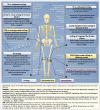The epigenetic players and the chromatin marks involved in the articular cartilage during osteoarthritis
- PMID: 36733912
- PMCID: PMC9887161
- DOI: 10.3389/fphys.2023.1070241
The epigenetic players and the chromatin marks involved in the articular cartilage during osteoarthritis
Abstract
Epigenetics defines the modifications of the genome that do not involve a change in the nucleotide sequence of DNA. These modifications constitute a mechanism of gene regulation poorly explored in the context of cartilage physiology. They are now intensively studied by the scientific community working on articular cartilage and its related pathology such as osteoarthritis. Indeed, epigenetic regulations can control the expression of crucial gene in the chondrocytes, the only resident cells of cartilage. Some epigenetic changes are considered as a possible cause of the abnormal gene expression and the subsequent alteration of the chondrocyte phenotype (hypertrophy, proliferation, senescence…) as observed in osteoarthritic cartilage. Osteoarthritis is a joint pathology, which results in impaired extracellular matrix homeostasis and leads ultimately to the progressive destruction of cartilage. To date, there is no pharmacological treatment and the exact causes have yet to be defined. Given that the epigenetic modifying enzymes can be controlled by pharmacological inhibitors, it is thus crucial to describe the epigenetic marks that enable the normal expression of extracellular matrix encoding genes, and those associated with the abnormal gene expression such as degradative enzyme or inflammatory cytokines encoding genes. In this review, only the DNA methylation and histone modifications will be detailed with regard to normal and osteoarthritic cartilage. Although frequently referred as epigenetic mechanisms, the regulatory mechanisms involving microRNAs will not be discussed. Altogether, this review will show how this nascent field influences our understanding of the pathogenesis of OA in terms of diagnosis and how controlling the epigenetic marks can help defining epigenetic therapies.
Keywords: cartilage; gene regulation; histone and DNA modifications; inflammation; osteoarthritis.
Copyright © 2023 Lafont, Moustaghfir, Durand and Mallein-Gerin.
Conflict of interest statement
The authors declare that the research was conducted in the absence of any commercial or financial relationships that could be construed as a potential conflict of interest.
Figures



References
Publication types
LinkOut - more resources
Full Text Sources

